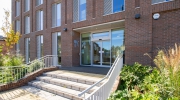About Warwick
Maybe taking the name of a famous castle city seemed like a short cut to gaining recognition and familiarity, but whatever the reason this very much not-in-Warwick university is an academic colossus with a reputation many struggle to match.
Based on the edge of Warwickshire, close to the delights of Coventry and Leamington Spa, the main campus is at least half an hour on the bus to Warwick castle... So a day trip will be needed to get the obligatory postcard and photo opportunity. As a leader in traditional subjects as well as the more contemporary fields of study, the University of Warwick is a popular name on those ever important UCAS applications.
The campus space is split between three areas, all combined covering almost 750 acres in academic buildings and student digs based amongst landscaped gardens and wooded spots for natural escapes from study books and stress. The nightlife of nearby Leamington and Coventry offer plenty that all but the fussiest will enjoy, with the tills in Leamington’s drinking holes singing to the sound of student dollar.
Culturally Warwick students are in for a treat, with one of the finest Arts Centres around on campus. Claiming an art gallery, two theatres, concert hall and a cinema all under its collective roofs, the Warwick Arts Centre is a big supplier of student employment and is home to some of the more iconic structures the site has to offer.
Points of Interest
Map Key
- City Centre
- The University of Warwick
Video
Student Accomodation in Warwick
Nearby Universities
Interesting Facts
There has been human activity at Warwick as early as the Neolithic, and constant habitation since the 6th century. A Saxon burh was created at Warwick in the 9th century and Warwick Castle was established on the site in 1068
William the Conqueror used enforced Anglo-Saxon labour for work on the construction of Warwick Castle. The wooden castle was replaced by a fortified stone castle in 1260
The Great Fire of Warwick in 1694 destroyed much of the medieval town and as a result most of the buildings post-date this period
